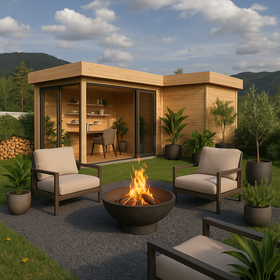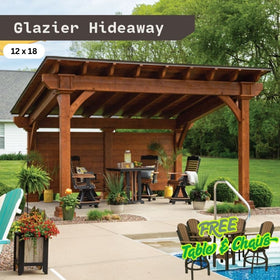512-777-0154

Micro Homes vs. Tiny Homes: Comparison of Size, Cost, and Legal Limits
Thinking about downsizing, but not sure how small is too small? The debate of micro homes vs tiny homes is a hot topic among people chasing simpler, more affordable living.
Micro homes are smaller and ultra-efficient, while tiny homes give you more flexibility and comfort.
If you’re curious which fits your lifestyle best, stay because the differences go way beyond square footage.
Defining the Dimensions: Micro, Tiny, and Small
Before choosing your perfect small home, it helps to understand the size categories. Not all tiny homes are created equal. Some are cozy; others feel like high-end camping with walls.
The Legal Standard: Maximum Tiny House Square Footage
According to Appendix Q of the International Residential Code (IRC), a true tiny home measures 400 square feet (about 37 sq. meters) or less.
That number might sound small, but it’s enough for a compact kitchen, living space, and loft bed. The rule doesn’t count loft areas, so that cozy sleeping nook above your kitchen? Totally allowed.
This definition sets the standard for zoning and safety codes across most U.S. states.
What is a Micro Home? The Ultra-Minimalist Tier
Now, let’s zoom in even further. A micro home usually falls under 200 square feet (around 18.5 sq. meters).
Think of it as the minimalist’s dream home. Every inch has a job—stairs double as drawers, walls hide fold-down desks, and your bed might transform into your couch.
Micro homes focus on essential living. They’re ideal for people who love simplicity or spend more time outdoors than inside.
The Range of Small Homes: Up to 1,000 Square Feet
Move beyond 400 square feet, and you’ve entered the world of small homes. These typically range from 400 to 1,000 square feet (50–93 sq. meters).
This size gives you breathing room. You might have a separate bedroom, a full-size fridge, and even a bathtub. Some buyers still call these “tiny,” but in reality, they’re just comfortable compact homes with less clutter and lower bills.
Cost Analysis: Micro Homes vs. Tiny Homes Price and Cost
Let’s talk numbers. The price difference between micro, tiny, and small homes can be as big as the size gap itself.
Initial Purchase Price: Shell, DIY, or Turnkey?
The first big decision is how you buy or build your home. Some people go for kits, others hire professionals.
| Type | Typical Price Range | Notes |
|---|---|---|
| Micro or Kit Home | $10,000 – $40,000 | Great for DIY or prefab builds |
| Tiny House on Wheels | $60,000 – $120,000 | Includes mobility and full setup |
| Small House on Foundation | $100,000 – $250,000 | Feels like a traditional home |
A couple who built their own micro cabin in the woods spent just under $25,000 by doing most of the work themselves. Compare that to someone hiring a builder for a small home; they could easily hit six figures before adding furniture.
Hidden Costs and Long-Term Expenses
The sticker price is only the beginning. You’ll also need to budget for:
- Land: Buying or leasing property adds to the total.
- Utilities: Hooking up water, septic, and electricity can cost thousands.
- Permits: Expect fees for inspections and local approvals.
- Foundations: A permanent base boosts comfort and resale value but costs extra.
If you plan to move your home often, skip the foundation but prepare for ongoing maintenance costs.
Financial Comparison: Cost Per Square Foot
Small homes often cost more per square foot than larger ones. Why?
Because each square foot holds the same expensive essentials—plumbing, appliances, insulation. When those features are packed into a tighter space, the cost density goes up. So yes, a 200-square-foot home can cost more per foot than a traditional house.
Financing the Purchase: Loan Types and ROI
Financing small homes isn’t one-size-fits-all either.
- Tiny and Micro Homes on Wheels often qualify for RV or personal loans, which can mean higher interest rates.
- Small Homes or Tiny Homes on Foundations usually qualify for mortgages, offering better terms and resale potential.
The trade-off? Wheels bring freedom but lower long-term value. Foundations bring security and appreciation over time.
Where to Buy: Finding Tiny Homes for Sale
So, where can you actually buy one of these small-space wonders? Luckily, options have exploded in recent years.
Tiny Home Builders and Custom Manufacturers
Across the U.S., dedicated tiny home builders create custom designs to fit every personality. From sleek Scandinavian cabins to rustic park models, you can find builders who specialize in everything from off-grid setups to luxury finishes.
Many of these are RV-certified, meaning they meet travel safety and insurance standards. Perfect if you’re planning to take your home on the road.
The Online Marketplace: Kits, Plans, and Prefabs
If you’re handy or adventurous, online platforms now sell home kits and prefab units you can assemble yourself.
Companies like Freedom Room and other modular retailers offer packages with all the materials and instructions you need. It’s a cost-saving path, but also a test of patience (and your ability to use a power drill without regret).
Zoning and Placement: Where Can I Legally Put My Home?
Before you sign any papers, check your local zoning laws.
Some cities allow Accessory Dwelling Units (ADUs) or tiny homes on private property. Others limit them to RV parks or specific communities. Skipping this research could lead to costly relocation later, so always read the fine print.
Mobility, Comfort, and Legal Hurdles
Mobility is part of the appeal of compact homes, but it also shapes how you live day to day.
Mobility and Foundation: Portability vs. Permanence
Tiny and micro homes on wheels, like Wanderlove Tiny Home, are great for people who crave movement. They can hit the road at a moment’s notice.
On the other hand, small homes on foundations, like Sigrid 70 Garden Room, offer more stability, comfort, and a sense of belonging. If you value community and routine, you’ll probably lean toward a permanent setup.
The Comfort Trade-Off: Amenities and Livability
Micro homes are cozy and efficient, but they sacrifice some everyday comfort. You’ll find smaller appliances, fewer walls, and multipurpose furniture everywhere.
Small homes, by contrast, can feel surprisingly spacious. You get a real kitchen, a separate bedroom, and maybe even a couch that doesn’t need to double as your bed.
Zoning and Permits: The Code that Matters More Than Size
What truly defines your home isn’t its size, it’s how it’s classified.
- RVIA/ANSI certification means your home is considered mobile, with limited insurance and financing options.
- IRC compliance puts it under residential building codes, which helps with mortgages, taxes, and resale value.
Your classification affects everything from property taxes to long-term security, so this is one area you don’t want to overlook.
Making the Right Choice for Your Minimalist Future
When it comes to micro homes vs tiny homes, there’s no single winner. It all depends on what you value most.
If you crave freedom, simplicity, and affordability, a micro or tiny home on wheels could be your ticket to adventure. But if you prefer stability, comfort, and long-term investment, a small home on a foundation makes more sense.
Either way, downsizing is less about losing space and more about gaining freedom: financial, emotional, and environmental.
And who knows? That smaller home might just open up a bigger life.







